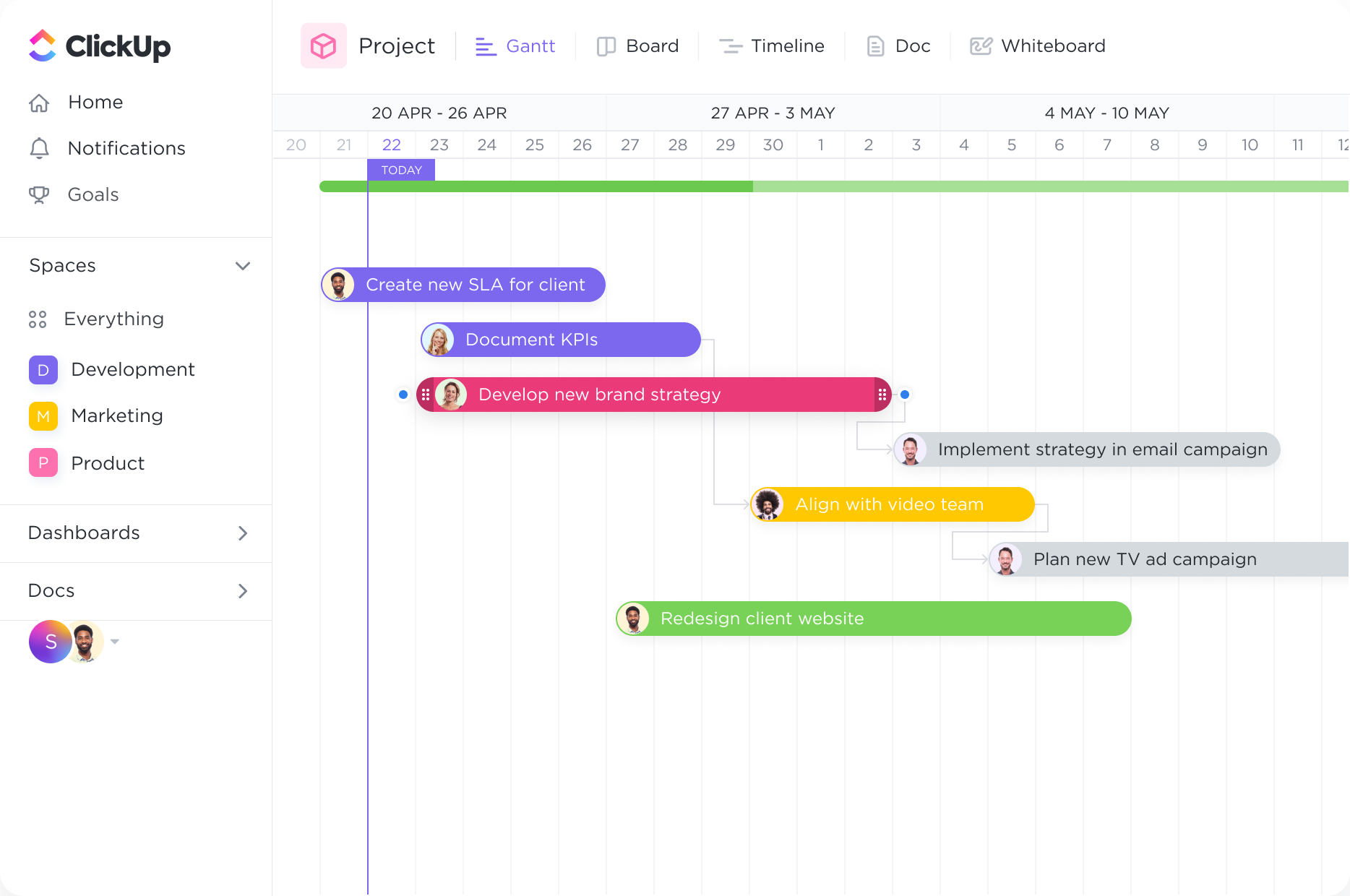Tracking
Eliminate bottlenecks before they happen.
Intelligent dependency-path tracking shows you where potential bottlenecks might exist to prevent inefficiencies.
Gantt Charts
Create powerful Gantt Charts that captivate Directors and drive project success with ClickUp. Streamline your project planning and execution with our intuitive software, designed to empower you in achieving your goals. Easily visualize project timelines, allocate resources, and track progress, all in one place. Experience the efficiency and effectiveness of ClickUp's Gantt Chart software and take control of your projects like never before.
Free forever. No credit card.

Tracking
Intelligent dependency-path tracking shows you where potential bottlenecks might exist to prevent inefficiencies.
Dependencies
Create tasks and link them with dependencies. Dragging a task with dependencies will automatically reschedule tasks in the chain
Directors play a crucial role in overseeing the production of films, and Gantt charts can be a valuable tool in their toolkit. A Gantt chart allows directors to plan and schedule each phase of the film production process, from pre-production to post-production. This includes tasks such as script development, casting, location scouting, filming, editing, and marketing. By visualizing the timeline and dependencies of each task, directors can effectively manage resources, coordinate with the production team, and ensure the project stays on track.
Directors are often responsible for managing the budget of a film project. Gantt charts can help directors track and allocate costs throughout the production process. By assigning budgetary tasks to specific timeframes and monitoring expenses against the planned budget, directors can ensure that financial resources are effectively utilized and that the project stays within budget. This level of financial visibility allows directors to make informed decisions and adjust spending priorities as needed.
Coordinating the schedules of the cast and crew is a critical aspect of film production. Gantt charts can assist directors in creating a comprehensive schedule that includes availability, shoot dates, and other commitments. By visualizing the schedule, directors can identify potential conflicts, plan shoot days efficiently, and communicate the schedule effectively to the team. This ensures that everyone involved in the production is aware of their responsibilities and can work together seamlessly.
Directors are involved in the post-production phase of a film, which includes tasks such as editing, sound design, visual effects, and finalizing the film for distribution. Gantt charts can help directors manage the complex workflow of post-production by outlining the tasks and their dependencies. This allows directors to track the progress of each task, ensure timely delivery, and maintain quality control throughout the editing and post-production process.
Once the film is complete, directors are often involved in marketing and distribution strategies. Gantt charts can assist directors in planning and executing marketing campaigns, film festivals, premieres, and distribution timelines. By visualizing the various components of the marketing and distribution process, directors can coordinate efforts, allocate resources, and ensure that the film reaches its intended audience effectively. This level of organization and coordination can contribute to the success and visibility of the film.
A Gantt chart can provide a visual representation of project timelines and milestones, allowing directors to easily track the progress of various projects and ensure they are on schedule.
Directors can use a Gantt chart to allocate resources and assign tasks to team members, ensuring that workloads are balanced and that resources are being utilized effectively.
A Gantt chart can help directors identify dependencies between different tasks or projects, as well as the critical path that determines the minimum amount of time required to complete a project. This allows them to prioritize tasks and make informed decisions about resource allocation.
By sharing a Gantt chart with stakeholders, directors can effectively communicate project timelines, progress, and any potential delays or roadblocks. This ensures that all stakeholders are on the same page and can make informed decisions based on the updated project status.
Directors often oversee multiple projects simultaneously, and a Gantt chart can help them visualize and manage the interdependencies between these projects. This allows for better coordination and ensures that projects are not negatively impacting each other's timelines.
With a Gantt chart, directors can easily identify any delays or bottlenecks in the project timeline and take appropriate actions to address them. This could involve reallocating resources, adjusting timelines, or resequencing tasks to keep the project on track.
Gantt chart software offers several key benefits for project management including improved project planning and scheduling, enhanced communication and collaboration among team members, better resource allocation and utilization, increased visibility into project progress and milestones, and the ability to track and manage dependencies and critical paths effectively.
Gantt chart software can help directors by providing a visual representation of project timelines, tasks, and dependencies. This allows them to easily monitor project progress, identify potential delays, and make necessary adjustments to ensure timely completion. Directors can track task completion, identify bottlenecks, and allocate resources effectively, improving overall project management and facilitating timely delivery.
Directors should look for Gantt chart software that offers features such as resource allocation, task dependencies, and timeline visualization. These features enable directors to track project progress, identify potential bottlenecks, and allocate resources efficiently across multiple projects, ensuring effective management and timely completion of all projects.